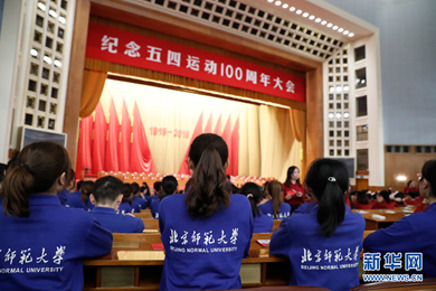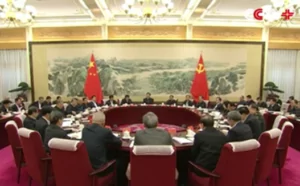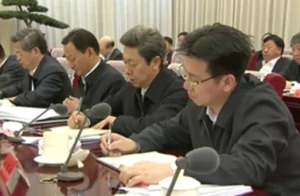
“Study May Fourth,” But Not June Fourth: The CCP Seeks Control of China’s Historical Legacies
Publication: China Brief Volume: 19 Issue: 11
By:

Introduction—The Chinese Government’s Official Narrative on the Tiananmen “Turmoil”
Ever since the tragic events of the 1989 Beijing Massacre, the ruling Chinese Communist Party (CCP) has maintained a rigid official narrative regarding the “turmoil” (dongluan, 动乱) of spring 1989. [1] This narrative states that the anti-corruption, pro-democracy protests of spring 1989 were “anti-Party, anti-socialism activities” (fan dang fan shehuizhuyi de huodong, 反党反社会主义的活动) directed at overthrowing the state; and that the violence resulted from “a minority of violent rioters” (shaoshu baoluan fenzi, 少数暴乱分子) who had “incited some people to oppose the martial law troops” tasked with restoring order. Per the official verdict, “This political disturbance wrecked our country’s normal social order, threw the course of normal economic development into disarray, and brought about enormous harm for the party, nation, and people.” [2]
While this terse narrative has been maintained within CCP channels, in the years since Tiananmen the state-controlled press of the People’s Republic of China (PRC) has vigorously suppressed broader public discourse regarding the massacre. [3] Chinese citizens making even muted or oblique protests related to the “June 4 Incident” (Liu-Si Shijian, 六四事件) have been made subject to harsh punishments—as with four men arrested in Sichuan in 2016, after they placed labels that memorialized the 1989 protest movement onto liquor bottles (SCMP, April 4).
With this in mind, many foreign observers were surprised when PRC Defense Minister Wei Fenghe (魏凤和) referred to the massacre in comments made on June 2 at the Shangri-La Dialogue in Singapore. When prompted by a reporter, Wei commented that the events of 1989 were “political turbulence and the central government took measures to stop the turbulence, which is a correct policy.” Wei further stated that, due to the government’s actions in 1989, “China has enjoyed stability and development” over the past thirty years (BBC, June 2). This message was reinforced in even starker terms in a June 3 editorial in the state-controlled, nationalist outlet Global Times. The editorial, titled “June 4 Immunized China Against Turmoil,” invoked the collapse of other Communist states by saying that “[t]he Chinese government’s control of the incident in 1989 [was] a watershed marking the differences between China and former Eastern European socialist countries, including the Soviet Union and Yugoslavia.” The editorial also asserted that “[d]ropping the incident thereafter has… [allowed] the country [to] leave the shadow behind, avoid disputes, and help all Chinese people face the future” (Global Times, June 3).
Although Wei and the editorial adhered to the official narrative, some foreign observers might have been startled to hear official PRC sources making any mention whatsoever of the taboo topic of June 1989. However, these two sources were both directed at foreign audiences: Wei was speaking at an international forum held abroad, and the editorial was in the English-language edition of the Global Times. These messages have not been repeated in China’s domestic press. [4] At home, the CCP leadership would prefer not to speak about Tiananmen at all.
Appropriating the May Fourth Movement
Rather than attempting to justify the government’s actions during the Tiananmen crisis thirty years ago, throughout spring 2019 the CCP propaganda apparatus focused attention on another anniversary: the centennial of the “May Fourth Movement” (Wu-Si Yundong, 五四运动), an intellectual movement that grew out of student protests on May 4, 1919 against the provisions of the Treaty of Versailles. [5] Although the original May Fourth protests were motivated by specific grievances, the protests became the symbol and name for a broader intellectual renaissance in education, culture, and political thought. Per the official narrative promoted by the CCP today, the May Fourth Movement represented the awakening of modern Chinese patriotism, and provided the intellectual ferment that gave birth to the Communist Party—which was itself to become the institutional mechanism that saved China from backwardness and foreign imperialism.
This message was promoted by state media in April and May under the slogan “Strengthen Study of the May Fourth Movement and the May Fourth Spirit” (Jiaqiang dui Wu-Si Yundong he Wu-Si Jingshen de Yanjiu, 加强对五四运动和五四精神的研究). CCP General Secretary Xi Jinping took an active role in this propaganda campaign, giving a speech before the Politburo on April 19 in which he called the “May Fourth Spirit” a key part of “achieving the great rejuvenation of the Chinese people.” Xi’s comments focused on the importance of instilling this spirit in young people, and revealed his concern for youth indoctrination: this effort, Xi said, must “clarify the relationship between the Chinese Communist Party and the Chinese youth movement, [and] strengthen political leadership of the mass of youth, guiding the mass of youth to consciously persist in the Party’s leadership, to hear the Party’s words, and walk the Party’s path” (Central People’s Broadcasting, April 21).


In case anyone were to somehow miss the message from Xi’s speech, the broader propaganda campaign reiterated in other venues the need for CCP control over the thoughts and endeavors of young people. As written in People’s Daily by Zheng Shiqu (郑师渠), a professor at Beijing Normal University, one of the key lessons to be learned from the May Fourth Movement is that “student movements must merge with the mighty currents of the people’s national revival, and receive proper guidance, in order to have positive prospects” (People’s Daily, April 30). In line with this emphasis, official events commemorating the anniversary emphasized activities for young people, especially university students (see accompanying image).
Despite the efforts of official propaganda to maintain a positive (albeit totalitarian) tone surrounding the centennial of the May Fourth Movement, there were clear signs that regime security officials were nervous about the anniversary. In late April and early May, police presence was stepped up around universities in Beijing, to include increased identification checks and random inspections (Radio Free Asia, May 3). An extended four-day public holiday was declared following the traditional May Day holiday—officially as part of an effort to boost public shopping consumption, but also possibly an effort to prevent mass meetings from forming at schools or workplaces. In late April, six members of Beijing University’s Marxist Study Society—who have run afoul of authorities in the past due to activities intended to raise attention to the plight of poor workers—were arrested in an apparent round-up of potential troublemakers prior to the anniversary (CNN, May 1).
Conclusions
The Chinese government has long been sensitive about anniversary dates that might become focal points for dissent or public unrest—or simply for discussions that might range beyond the Party’s official version of history. The contrasting treatment of the 30th anniversary of the Tiananmen Massacre, and the 100th anniversary of the May Fourth Movement, reveals two dramatically different approaches: continued suppression of discourse regarding the former; and “flooding the zone” with propaganda and activities in relation to the latter. In all of this, there is clear concern for the direction that might be taken by student activism, if not made subject to proactive government control.
Few ways exist to spin memories of the June 1989 massacre into a convincing narrative sympathetic to the regime. However, the May Fourth Movement offers the CCP a potentially much more attractive narrative: one that extols the role of young people in shaping China’s “revival,” while also presenting a positive origin story for the Party and emphasizing its continued role in leading the way towards China’s future. Which narrative proves to be more enduring among China’s younger generation remains to be seen.
John Dotson is the editor of China Brief. Contact him at: cbeditor@jamestown.org.
Notes
[1] This terminology dates all the way back to the April 26, 1989 editorial in People’s Daily that set the stage for the CCP’s narrative, and which heralded the ultimate violent suppression of the protest movement. See: “We Must Raise the Banner to Clearly Oppose Turmoil” [Bixu Qizhi Xianming de Fandui Dongluan, 必须旗帜鲜明地反对动乱], People’s Daily, April 26, 1989. https://news.ifeng.com/history/today/detail_2010_04/26/1089387_0.shtml.
[2] Eighty Important Events in the History of the Chinese Communist Party [Zhonggongdang Shishang de 80 Jian Dashi, 中共党史上的80件大事], No. 72: “The Political Disturbances of 1989” [1989 Nian Zhengzhi Fengbo, 1989年政治风波], June 13, 2001. https://www.people.com.cn/GB/shizheng/252/5301/5302/20010613/488133.html.
[3] Louisa Lim, The People’s Republic of Amnesia: Tiananmen Revisited (Oxford University Press, 2014).
[4] The author has been unable to identify newspaper articles or other sources in the state-controlled Chinese press that either reported on Wei Fenghe’s comments, or echoed the narrative of the cited English-language Global Times editorial. The domestic PRC press has remained silent about the anniversary of June 1989.
[5] The Treaty of Versailles granted Japan control over former German-controlled territory on the Shandong Peninsula. The May Fourth Movement contained an element of anti-Japanese patriotism due to this issue–as well as due to Japan’s “Twenty-One Demands” made in 2015, which granted Japan significant influence in Manchuria and over China’s weak government in Beijing.



